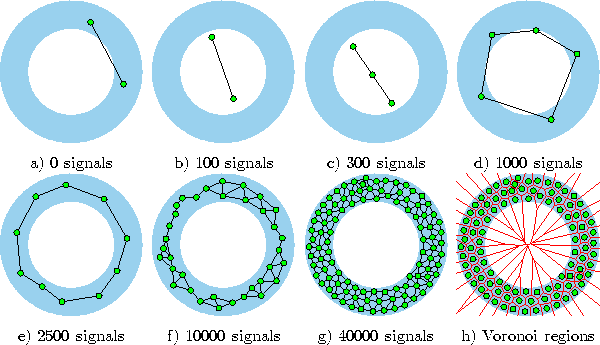



Next: Other Methods
Up: Soft Competitive Learning without
Previous: Neural Gas plus Competitive
This method (Fritzke, 1994b, 1995a) is different from the
previously described models since the number of units is changed
(mostly increased) during the self-organization process. The growth
mechanism from the earlier proposed growing cell structures (Fritzke, 1994a) and the
topology generation of competitive Hebbian learning (Martinetz and Schulten, 1991) are combined to a
new model. Starting with very few units new units are inserted
successively. To determine where to insert new units, local error
measures are gathered during the adaptation process. Each new unit is
inserted near the unit which has accumulated most error. The complete growing neural gas algorithm is the following:
- 1.
- Initialize the set
 to contain two units
to contain two units  and
and 

with reference vectors chosen randomly according to
 .
.
Initialize the connection set  ,
,  , to the empty set:
, to the empty set:

- 2.
- Generate at random an input signal
 according to
according to  .
.
- 3.
- Determine the winner
 and the second-nearest unit
and the second-nearest unit 
 by
by

and

- 4.
- If a connection between
 and
and
 does not exist already, create it:
does not exist already, create it:

Set the age of the connection between  and
and  to zero
(``refresh'' the edge):
to zero
(``refresh'' the edge):

- 5.
- Add the squared distance between the input signal and the
winner to a local error variable:

- 6.
- Adapt the reference vectors of the winner and its direct
topological neighbors by fractions
 and
and  ,
respectively, of the total distance to the input signal:
,
respectively, of the total distance to the input signal:

Thereby  (see equation 2.5) is the set of direct topological
neighbors of
(see equation 2.5) is the set of direct topological
neighbors of  .
.
- 7.
- Increment the age of all edges emanating from
 :
:

- 8.
- Remove edges with an age larger than
 . If this results in
units having no more emanating edges, remove those units as well.
. If this results in
units having no more emanating edges, remove those units as well.
- 9.
- If the number of input signals generated so far is an integer
multiple of a parameter
 , insert a new unit as follows:
, insert a new unit as follows:

- Determine the unit q with the maximum accumulated
error:


- Determine among the neighbors of q the unit f with the maximum accumulated error:


- Add a new unit r to the network and interpolate its reference vector from q and f.


- Insert edges connecting the new unit r with units q and f, and
remove the original edge between q and f:


- Decrease the error variables of q and f by a fraction
 :
:


- Interpolate the error variable of r from q and f:

- 10.
- Decrease the error variables of all units:

- 11.
- If a stopping criterion (e.g., net size or some performance
measure) is not yet fulfilled continue with step 2.
Figure 5.7 shows some stages of a simulation for a simple ring-shaped data distribution. Figure 5.8 displays the final results after 40000 adaptation steps for three other distribution.
The parameters used in both simulations were:  ,
,
 ,
,  ,
,  ,
,  ,
,  .
.

Figure 5.7: Growing neural gas simulation sequence for a ring-shaped uniform probability distribution. a) Initial state. b-f) Intermediate states. g) Final state. h) Voronoi tessellation corresponding to the final state. The maximal network size was set to 100.

Figure: Growing neural gas simulation results after 40000 input signals for three different probability distributions (described in the caption of figure 4.4).




Next: Other Methods
Up: Soft Competitive Learning without
Previous: Neural Gas plus Competitive
Bernd Fritzke
Sat Apr 5 18:17:58 MET DST 1997
![]() ,
, ![]() , to the empty set:
, to the empty set:
![]()
![]() ,
,
![]() ,
, ![]() ,
, ![]() ,
, ![]() ,
, ![]() .
.

